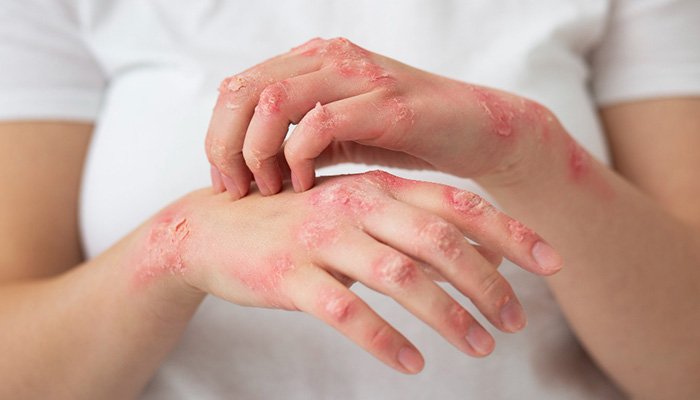Your 4 month old baby has a stuffy nose. He is not as playful and active as he used to be. You are scared it may a bad infection. At the same time you are anxious how to care for the little one.
About bronchiolitis
Bronchiolitis is a common inflammatory disease of the bronchioles, the smallest airway branches in the respiratory tree. The inflammation causes the bronchioles to swell up and secrete mucus that builds up in the lumen of these passages to block the airway. This narrowed passage for air causes a difficult breathing.
Bronchiolitis is an infection caused by a virus. The commonest causative virus is the Respiratory syncytial virus (RSV). Others that are believed to be causative are the adenovirus, and the influenza and parainfluenza viruses. The infection is most common in children aged less than 2 years, usually those 3 to 6 months in age. It is a seasonal infection that is more in the fall and winter months and more than one episode can occur in one season.
Any baby below the age of 6 months is at risk of acquiring the infection. This is because the lungs and the disease fighting defenses called the immune system are not mature enough in the early months of life. More boys than girls develop the infection. Other risk factors include babies who are not breast-fed, those who are born premature, those who are sent to a child care where other children may have the infection, or having a sibling who visits school or a child care and brings home the infection. Babies with an underlying medical problem in the heart or lung and those with a weak immune system are more prone to the infection.
Symptoms
Bronchiolitis may begin as a minor respiratory illness with symptoms similar to a common cold. The child may have a stuffy or runny nose, and a low-grade fever may or may not be present. A dry and irritating cough may be present. After around a week, the disease may progress to worsen the symptoms. The child may develop a rapid and more difficult breathing. There may be a wheeze, a whistling sound when the child breathes out. The heart rate may also go up. The illness usually resolves in a week or two.
In others, the infection may progress to a florid disease with increasingly labored breathing with flaring of nostrils, fatigue, and a sick child. The baby becomes irritable, anxious, may cry persistently, and there may be retraction of the chest wall in between the ribs with every effort to breathe. The baby becomes pale and then blue. This shows inadequate oxygenation and is a grave sign. The child appears dehydrated and may go into a severe respiratory failure. These warrant hospitalization and emergency management.
Caring for the child
The child should be offered loving and comforting care. The baby should be held upright to allow easier breathing and spacious airways. Feed breast milk at frequent intervals. Fluids like juices and water may be offered in small frequent sips. Saline nasal drops available over-the-counter may be instilled in each nostril to clear the passages. The baby should be returned to upright position after the drops have been instilled. The nostrils may be cleared with a small suction bulb taking care not to push the suction nozzle too far into the nose. If the child develops a slight fever, over-the-counter drops of medicines like paracetamol may help. The room where the child is nurtured should be kept clean, free from smoke, and with a comfortable temperature. The air should be well humidified. Dry air is an irritant for nasal passages. Using a humidifier or vaporizer can help to make coughing easier and clear the congestion in nose and respiratory passages. The child should be allowed to take plenty of rest and should be closely watched for any worsening of respiratory distress.
It is important to see a doctor or a healthcare provider if the child becomes too sick and irritable. Bluish discoloration of the skin, lips, and fingers, called cyanosis is a bad sign. A distressing cough, rapid shallow breathing, retraction of chest wall with breathing, and flaring of nostrils are other symptoms that need medical attention. A lethargic child who does not respond to commands and who persistently refuses to drink needs to be taken to a doctor.
Diagnosis
The doctor may ask for the severity and duration of symptoms, and may look for any specific conditions that predispose to bronchiolitis. In addition, the doctor may enquire about the feeding habits and any vomiting, and may look for signs of dehydration like a sunken skin, dry mouth, and reduced urination. When required, the doctor may like to do a chest X-ray to see the condition of the lungs and check for any other illnesses. A sample of the mucus may be collected by using a swab or a suction catheter and it may be tested for the causative viruses in a laboratory. Blood tests may be done for levels of oxygen in the blood and for the count of white blood cells (WBCs). The WBCs are commonly increased in situations where the body fights an infection.
Treatment
The doctor may offer help and advice to help the child feel better. If an accompanying bacterial infection is suspected, the doctor may prescribe a course of antibiotics. In the very severe cases, antiviral medicines like ribavarin may be prescribed, though not in all cases. If the child is too sick, the doctor may advise hospitalization. The child is then given humidified oxygen through a mask and fluids to maintain dehydration. The fluids may be given through a superficial blood vessel.
Bronchiolitis is contagious
Bronchiolitis is contagious. The infection may spread from one person to another. This is why children in day care centers are more likely to get the infection. Families who live in unhygienic and crowded conditions are more at risk of infection. Children, however can be protected with some precautions. If one has a cold, the hands should be washed thoroughly with soap and water before the baby is touched. A face mask may be of help to prevent spread of infection. A sick child should be kept at home and should not be sent to the day care. Cleanliness will help to prevent the sustenance of the causative viruses. The kitchen and bathrooms in particular should be kept clean and disinfected. Tissues used to wipe the baby’s nose and mouth should never be reused. The bottles, glasses, or sippers of the baby should not be shared with anybody. Hands should be washed frequently and a sanitizer should be carried when going out of home. No vaccines are available so far to prevent the infection. Some children who are at high risk may be advised to take palivizumab injection once a month in the peak winter season when the infection is more likely. This may last from November to March.
Outlook
Your baby may become very uncomfortable, when suffering from bronchiolitis. Therefore, offer your baby the most loving care. Proper care can help to fight an episode of infection and precaution can prevent the spread of infection. Timely medical help is important in bronchiolitis.



